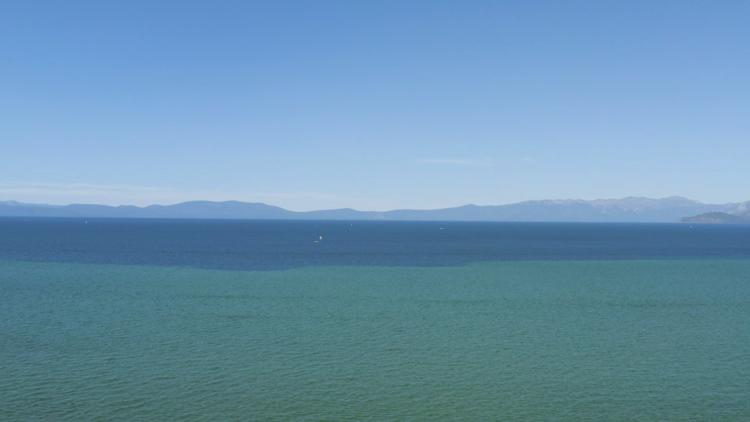SOUTH LAKE TAHOE, Calif. — Lake Tahoe — the largest freshwater alpine lake in North America — is world-famous for its clear blue water, but the lake faces a multitude of threats requiring constant care and vigilance to keep it that way.
“We're more than a bumper sticker," said Laura Patten, the Natural Resource Director at the League to Save Lake Tahoe, better known as Keep Tahoe Blue. "We really rely on the science to figure out what is happening in the lake."
Patten and other scientists studying Lake Tahoe say climate change and recreation pose the biggest threats to the lake in the 21st century. Longer and hotter periods of heat, more extreme fire seasons, and erratic precipitation patterns in the winter all play a part in Tahoe's water quality.
"We need to think about how are we going to plan for that potential climate future of Lake Tahoe," said Patten. "If we're seeing different patterns in precipitation, in smoke and ash and wildfire, how are we seeing these different pressures impact the lake?"
It's important to understand Tahoe’s crystal "blue" water is actually clear. The clear water reflects the blue sky and absorbs red light, making the water appear brilliant hues of blue. The clearer the water — or the better the water’s quality — the bluer the lake.
"When we think about Lake Tahoe's water quality and the threats that are impacting the water quality today, there are a number of them and they're interactive," said Dr. Sudeep Chandra, Director of the University of Nevada’s Global Water Center.
Chandra is an expert in freshwater lakes, studying numerous lakes from Southeast Asia to the Eastern Sierra.
"We're adding species to the lake unintentionally and often illegally and those species can reorganize how nutrients are given to algae that grow at the edge of the lake," said Chandra.
Algae most often forms in warm and relatively calm waters. Excess nutrients like nitrogen and phosphorus enter the lake via agricultural or stormwater runoff and can act as fertilizer for algae and bacteria growth.
Importantly, not all algae is toxic. But when toxic algae is present, it can be extremely harmful to the ecosystem. When toxic algae overgrowth — known as a harmful algal bloom or HAB — is detected, caution signs are put up around Tahoe warning of the dangers.
"One thing we're concerned about with shifting climate is that if the nutrients get delivered at the right time and the temperatures are elevated, we might select for more harmful algal blooms," said Chandra.
But could Tahoe turn green? We've seen other lakes in California struggle against and even lose the battle against algae, turning the water green.
When a harmful algal bloom happens, options to fight it are limited. It's better and cheaper to stop HABs before they happen, but it's not just algae posing a threat to Tahoe's water quality.
Invasive aquatic plants are also a problem, and these are most often introduced to the lake via unscrupulous boaters and boarders.
"One thing that we really focus on is the prevention of the spread of aquatic invasive plant species," said Patten. "That's really integral to making sure that we keep Tahoe blue and not green. Aquatic invasive plant species make their way primarily through boats. They can also make their way into Tahoe through something like a paddle board or a kayak so we really encourage everybody to clean, drain and dry. It's really up to everybody to make sure that they're not spreading aquatic invasive plants."
Boat inspections have been mandatory at Lake Tahoe since 2008, and permanent inspection stations are right now being placed on both the California and Nevada sides to help keep invasive species out.
Lake Tahoe is basically a giant granite funnel, so whatever happens in the greater Tahoe region has the potential to impact the lake. The Upper Truckee River carries sediment and other particle pollution into Lake Tahoe, which Patten says is the largest contributor to fine sediment pollution.
"We're really focused on restoring marshes and meadows so that those can act as big filters to make sure that those nutrients that feed things like weeds and feed things like algae are not getting into the lake," said Patten.
These marshes on the outskirts of the lake are essentially big filters, before the freshwater from the rivers meet up with the lake body itself. These marshes filter out the fine sediment before it gets into the lake, and the marshes also absorb excess nutrients, preventing algae growth in the lake itself.
The catch is there has been more building and development in some of the marshes. When we encroach on and change the dynamics of the marshland, the filter is less effective. Even with healthy marshes, some pollution isn't as easy to keep out of the lake.
Wildfire smoke can also deposit sediment into the lake which can decrease water quality and lead to algae growth, however, not all wildfire smoke has the same impact on the lake.
In 2021, the Caldor Fire raced towards South Lake Tahoe. Thick black smoke and ash fell into Lake Tahoe, and scientists were watching. The results were surprising. The smoke had less effect on algae growth than the very fine particles coming from fires hundreds of miles away.
"Not all smoke is created equal when you have fires," said Chandra. "When you have fires — for example the Caldor Fire at the south end of the basin in 2021 – that heavy smoke and ash that's deposited closer to the fire turns out to be less reactive and it doesn't grow as much algae. But the fine thin particles further away from the fire that maybe make the beautiful sunsets that we see, they actually have a lot of nutrients and metals that can stimulate algae growth."
Protecting the lake and keeping it blue really comes down to restoration.
"The more restoration that we can do in Lake Tahoe, the more we can protect it and keep Tahoe blue," said Patten, reciting her organization's mantra.
The federal government is helping to keep Tahoe blue. Since 1997, hundreds of federal projects have restored wetlands, reduced wildfire fuels and helped control invasive species. Congress just reauthorized the Lake Tahoe Restoration Act, extending funding of about $300 million to protect the lake’s water quality.
"Lake Tahoe is something that everybody cares about and that's just so incredible whether you're in DC or Sacramento," said Patten. "We have the tools to be able to respond to those [threats] because of how strong Lake Tahoe is with all of those counties, agencies, the community that lives here all really cares about it. We're really unique in that way."
Still, more can be done.
"We often get this question of like, well, if we continue on the current pace of activity, is the lake just going to change dramatically? I don't think we're quite there yet, but I do think we're on this teeter totter," said Chandra. "We just don't know, but I'm worried as a scientist — a conservation scientist — that unless we make some of these subtle changes that in 10 or 20 years, our kids won't have the ability to change things back. I'm not ready to give up on the lake and I'm not ready to say, 'Oh, it's all a disaster,' because there are little things that we can do that that would protect the lake in big ways into the future."
WATCH MORE ON ABC10 | California’s Dying Lakes





















